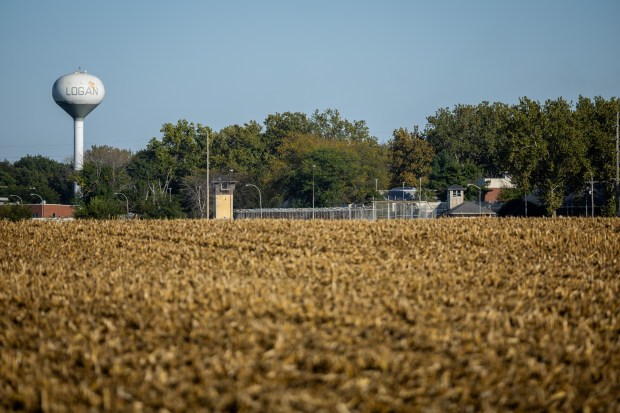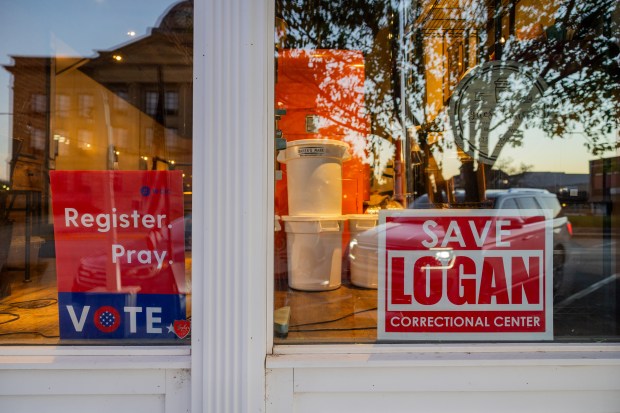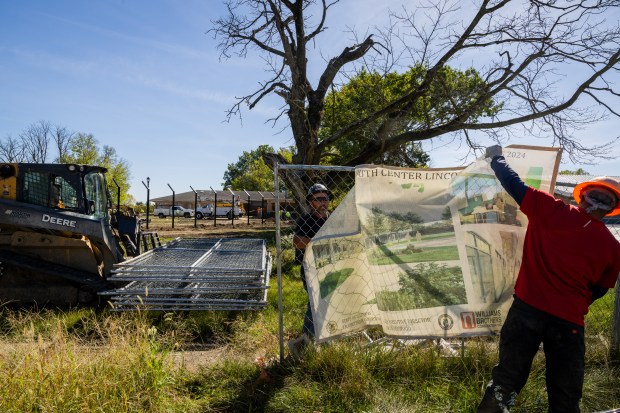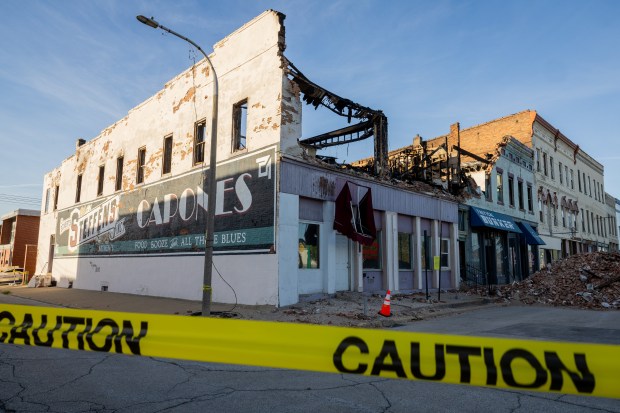LINCOLN, Ill. — Blanketed by thick smoke, Sangamon Street was blocked off by numerous firefighters, some of whom responded from more than 30 miles away, as they battled flames spouting from the roof of an old two-story building with apartments on its upper floor.
The strip just off downtown was known as “Dutch Row” many years ago because of the European heritage of business owners on a once-thriving block that included a grocery store, meat market and shoe store. A few dozen onlookers gazed at the late summer fire from down the street or across the railroad tracks. One passed along a rumor about Al Capone’s purported ties to the building, a nod to town lore that the Chicago gangster was an occasional visitor.
True or not, that was an era when the city of Lincoln, the only city in the nation named for Abraham Lincoln before he became president, was on the rise. For Charles Fricke, who is 73 and grew up in this town midway between Peoria and Springfield, looking at rundown properties around the site of the fire is bad enough but watching the flames ravage a building was akin to kicking a community while it’s down.
“It’s like a death, where you go through different stages,” said Fricke, a former Logan County coroner whose family owns a funeral home in Lincoln. “People have lost the economic impetus to move in. And now, it’s the eggshell collapsing because there’s no people that want to rebuild or redo and re-renovate some of these buildings. And it’s just gut-wrenching to see the community burning down in front of you.”
About 5 miles southwest, just outside the city limits, sits the Logan Correctional Center, a multi-level security prison for women. It’s adjacent to the Lincoln Correctional Center, a minimum-security men’s prison, and the Edward R. Madigan State Park, named after a former congressman from Lincoln who also was agriculture secretary under Republican President George H.W. Bush.
Gov. JB Pritzker’s administration has announced plans to demolish the aging women’s prison, and state officials have proposed relocating Logan 140 miles away to the site of Stateville prison near Joliet. The Lincoln Correctional Center would remain open.
The prospect of losing Logan and the nearly 500 jobs it provides would be the latest blow to a town of a little more than 13,000 residents that in recent years has lost a number of local institutions, including two colleges and a state developmental center.
“We just can’t keep taking hits like this. I mean, if it made sense to do this, then fine. But it doesn’t make no sense,” said Craig Eimer, 58, a Lincoln alderman who said his father and brother once worked at Logan. “It’s just completely a political move because somebody up there has got more power than anybody down here.”
The proposal to relocate Logan is part of a $900 million, multiyear plan that would also see Stateville Correctional Center demolished and rebuilt. An engineering and construction firm that was hired by the state to assess the Stateville site found it “can accommodate two new correctional facilities.”
Proponents of relocating Logan say it would give women incarcerated there better access to health care and other services that aren’t as readily available in central Illinois.

But the economic impact for Lincoln could be harsh. According to an April study from the University of Illinois, closing Logan would result in the direct loss of 493 jobs, while the Lincoln area could lose out on more than $61 million, a figure that includes county, state and federal taxes.
Outside the 120-year-old Logan County Courthouse, the center of Lincoln’s quaint downtown, a county official said the area is already trying to prepare for the costs of losing the Logan prison and acknowledged it could result in increasing taxes.
“Unfortunately, if it came down to it, it would have to be the only option. It wouldn’t be received well. I know we’re considered a conservative county. We are Republican,” Dale Nelson, vice chair of the Logan County Board, said after an evening board meeting. “Each department wants additional staff, things needed to be more effective, more efficiently. But sometimes you’ve got to cut back to make sure that we have enough contingency funds, we’re calling it, set aside.”


Logan County’s unemployment rate in August was 5.7%, slightly higher than Illinois’ 5.5%, which is one of the nation’s highest. Lincoln police Chief Joe Meister said one change he’s noticed over his 12 years in town is an increase in people experiencing homelessness.
“With the closure of institutions, with the closure of businesses, residents move out. Those houses, those properties don’t always sell and they remain vacant for a lengthy period of time and that brings folks who are suffering from homelessness into the city to find shelter in these places,” said Meister. “When I got here, we may have only had one or two homeless and now we have much more than that.”
In 2000, Lincoln’s population was 15,370, according to the U.S. census. By 2020, it was down to 13,288. One factor was the shuttering of the Lincoln Developmental Center, which then-Gov. George Ryan closed in 2002, citing unsafe conditions for disabled residents who he said would be better off in community-based settings. The facility employed about 660 people and served about 380 residents not long before it closed.
“One of the things that’s mentioned in the plan to remove Logan is that we have a declining population, which is ironic because it’s in part thanks to a decision made by the state,” said Andrea Runge, who heads Lincoln Economic Advancement and Development, commonly known as LEAD. “So, it’s kind of, in some ways, I think it feels a bit like kicking us while we’re down in a lot of different aspects.”
While a state-run juvenile justice facility is being built on a portion of the developmental center’s property, a big chunk of the site remains abandoned.
“When you go past the economics and start looking at the psychological impact, if you’re driving past something that is blighted for 20 years, does it affect how you feel about where you live?” Runge said.

In his City Hall office just off the town square, Lincoln Mayor Tracy Welch said he still sees businesses wanting to come to Lincoln but fears if the Illinois Department of Corrections moves Logan north that there could be a repeat of what happened when the developmental center was closed.
“I know IDOC has said that they’re going to try to help place everybody. But I think that there’s a lot more factors that people have to consider. I mean, these people have families. They have children. Some of them grew up here,” Welch said of Logan’s employees. “And when they leave … they take that revenue. We lose population. It makes it harder for us to grow the economy to entice businesses. I mean, it’s a domino effect.”
“When you think about it, simple things like sewers, they’re a huge consumer of our sewer system,” Welch said of Logan. “And the state pays the city of Lincoln for that usage. We would lose that revenue.”
The potential loss of prison employees wouldn’t be the only impact to the town’s revenue, he said.
“People that are incarcerated at those facilities have family and friends that do come see them,” said Welch. “And when they come to town, they stay in hotels overnight. They eat in our restaurants. They buy gas. All of that goes away if they were to relocate.”
Lincoln residents have learned to adapt when businesses or institutions close or scale back their operations.
Like many towns and cities in America, Lincoln also has been hit by the loss of manufacturing jobs. Patrick Fuller worked for 32 years at a glass container factory on Logan Street that turned out jars for Ragu spaghetti sauce and other products before it shut down in 2019. Fuller said the factory employed more than 500 people before automation cut down the work force. Later, only about 150 were employed at the factory when it ceased operations, the company said at the time.

The union jobs paid between $19 and $26 per hour, and provided a pension, Fuller said. While he’s now 65 and was able to retire, some of his co-workers had to move away.
“I could tell the last few years it was going downhill,” Fuller said, sitting in his home with Priscilla, his wife of 37 years. “You’ve got all these people and you’re only loading 10 trucks a day?”
“Every time something closes, it seems like the town is dying,” his wife said.
Ray Treuthart runs his family’s auto shop, which has been in business in Lincoln since the early 1980s. A lifelong town resident, he and wife both worked at the Logan Correctional Center and are now retired from the state prison system. He said people who worked at Logan and Lincoln Correctional Center are like family, and became a key customer base for his shop.
“Twenty (percent) to 40% of our business may come from Lincoln and Logan Correctional Center. Just depends on what time of the year it is,” Treuthart, 59, said. “But if you go over a whole year span, that’s about where we’re at.”
Treuthart said he worries about the effect Logan’s relocation will have on his employees.
“I’m fortunate enough, my wife’s fortunate enough that we’re both retired,” Treuthart said. “But, like, the guys that work for us, this is their livelihood. This is all they have. And I’m responsible for their families, their kids.”

Another fallout from the loss of Logan could be a drop in property values, said Diane Schriber, a lifelong resident who has worked in real estate for about 38 years. She’s concerned that if enough people move out the supply of homes will outstrip demand, resulting in a loss for homeowners who paid fair market value when the town was doing better.
“Each time we lose one of those major businesses, if something else doesn’t come in to take the place of it then what can the people do?” she said. “Again, outside of farming, Lincoln, Logan County is so dependent upon each one of those businesses.”
Situated off Interstate 55 and one of the towns along historic Route 66 until that road’s demise decades ago, Lincoln has long been a stop for travelers headed to or from Chicago or St. Louis.
In his 1998 book “Lincoln: A Pictorial History,” local historian Paul Gleason wrote that during discussions in the early 1850s about completing a railroad from the Mississippi River town of Alton, north of St. Louis, to Chicago, it was determined that a rail station should be built near the center of Logan County.
The county is named after Dr. John Logan, a former Illinois lawmaker and father of a Civil War general and U.S. senator bearing the same name. Centrally located between Springfield and Bloomington, it was considered an ideal site for steam trains frequently needing stops for water.
Virgil Hickox, a railroad official, John Gillett, a farmer and land owner, and Robert Latham, the Logan County sheriff, acquired the land after one of them bought it for $1,350 and the Illinois legislature voted to move the county seat from the town of Mount Pulaski to the area that would become Lincoln.
As proprietors of the newly acquired land, the three men needed legal counsel. Hickox was friends and neighbors with Abraham Lincoln, then a lawyer from Springfield, and the three men met in Lincoln’s law office to draft a power of attorney.
The group also named the town Lincoln. Lots for the town went up for sale in August 1853 and the future president, according to the book, “christened the townsite following the sale using the juice of a watermelon.”

In November 1860, President-elect Lincoln would make his last trip to his namesake city and addressed some of the citizenry.
“I have been shut up in Springfield for the last few months, and therefore have been unable to greet you, as I was formerly in the habit of doing,” Lincoln said, according to a New York Herald article cited in the book. “I am passing on my way to Chicago, and am happy in doing so to be able to meet so many of my friends, in Logan County, even if to do no more than exchange with you the compliments of the season, and to thank you for the many kindnesses you have manifested towards me.”
Agriculture was a lifeblood of Lincoln’s economy during its early history. Gleason’s book, citing census reports from 1870, stated there were over 321,700 acres in Logan County under cultivation that was divided into more than 2,500 farms. Coal mining also became a key economic driver by the late 1860s and many immigrants who settled in Lincoln worked at the mines.
By the early 1900s, manufacturing took shape and a number of factories operated in Lincoln, including the Pittsburgh Plate Glass Co., Lehn and Fink, the Lincoln Garment Co. and Eaton Corp., the only one of those four still open.
The Illinois China Co. moved to Lincoln in 1917 and was known as the only manufacturer of decorated semi-porcelain-ware in the state, selling its merchandise across the U.S. But during World War II, the company couldn’t keep up with orders. It didn’t have access to new machinery and there was a shortage of barrels to ship its products. After a change in ownership the business was renamed Stetson China Co. before it closed in the 1960s.
Beginning in the 1970s, the town sought to capitalize on its namesake with an annual “Railsplitter Festival,” a reference to the former president’s purported skills as a young man at chopping logs. In addition to a rail splitting competition, the festival has featured music, dancing, and events such as tomahawk throwing and an antique car show.

The festival also has held a reenactment of the christening of the city of Lincoln, with an Abraham Lincoln impersonator and other reenactors pouring watermelon juice on the ground.
Amid the economic decline of the current century, particularly the closure of the developmental center in the 2000s, the town made a push for another attraction paying tribute to the 16th president with a multimillion-dollar proposal to build a more than 300-foot monument of President Lincoln. The plans called for the statue to anchor a theme park and other amenities, but the project never came to fruition.
For many years, fall marked the arrival of many students at two local colleges. But those campuses are now virtually desolate.
Lincoln College closed its doors in 2022 after 157 years in operation. Administrators said the COVID-19 pandemic, among other things, crippled the college financially. Lincoln Christian University, which opened in the 1940s as the Lincoln Bible Institute, stopped offering its regular classes last spring.
Silas McCormick, LCU’s president from June 2020 until it closed, is now executive director of the Lincoln Christian Institute, which was part of the university. The institute offers non-credit biblical courses and functions as a support network for churches.
At its peak, about 17 years ago, the university enrolled about 1,000 students. When it closed, enrollment was around 250, almost half of whom graduated.
McCormick said the school took a big hit to enrollment during the pandemic, with many students finishing classes in the spring of 2020 and never returning. As the school was losing money, it sold property it didn’t need, paid down debt and retained its donors. But that wasn’t enough.
“The one thing we couldn’t do was convince enough students of our financial stability,” said McCormick. “And you’ve got to be honest with them. You can’t make assurances a student’s going to take three to five years to do a master’s in divinity. They want to know if you’re going to be there. And the problem is, not just us, lots of small schools, if they’re being intellectually honest, can’t say that they will.”
The early September fire just off downtown Lincoln left a few firefighters with minor injuries. It was more grim news for a city that’s been through a lot. But the fire also showed how a town can come together in a time of crisis, as citizens and businesses quickly donated food and water to the first responders along Sangamon Street.
“They’re our brothers. They’re our fathers. People’s neighbors. People that we know,” said Fricke, the former Logan County coroner. “So we try to support them.”



